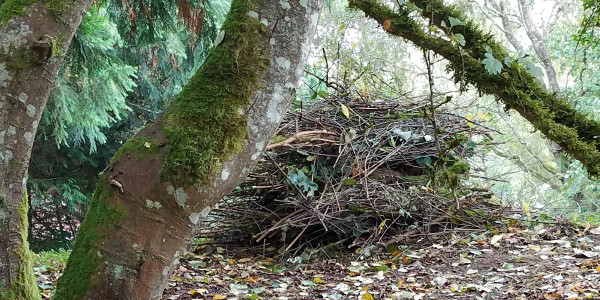Running time backwards to complete the circle of life
Several years ago our big, beautiful cherry tree, which grew on the hillside beside our house, toppled over during a vicious storm. We chopped it up for firewood, yielding more utility than did the cherries we were never able to eat because the crows and racoons always beat us to them. Then, after the tree came down, the sun invaded. Over the subsequent summers the hill became an exuberant, churning mass of green–Indian plums, scrubby oaks, salal, multitudinous weeds, and of course blackberries. Last fall we asked Cameron, our friend and gardener, to clear it out. Amazingly, he did the job in just a few hours, leaving behind a shaved hillside and an enormous pile of debris, looking like a woody khaki-colored haystack.
Now my chore was to deconstruct the haystack for transport to Tilz, our local yard waste facility. I began by grabbing the material at the top of the pile and transferring it to my wheelbarrow. My first handful was of course Cameron’s last—-I was experiencing time in reverse. I queried the collection of leaves and twigs and understood that at the very end of his work Cameron had raked the remaining bits of debris into a little mound, scooped it up, and tossed it on top to cap the stack. My next several armfuls were Indian plum branches. They lay in parallel in two- or three-foot lengths. I could see Cameron chopping down those little, disorderly trees, cutting them up, and gathering a bunch to place on the pile. So not only was I running Cameron’s time backwards, I was in a dialog with him: as I unstacked the pile, he was telling me how he’d constructed it. Further down—further back in time—was a thick layer of blackberry branches. Cameron was now telling me he had just chopped up a big blackberry bush and put the proceeds on the rapidly growing mound. Even this late in the year I saw some deep-black berries attached to the canes. Did Cameron notice them? Maybe so; maybe he ate his fill and these were the leftovers. Or maybe not. Maybe he doesn’t even like blackberries. Such details the stack did not disclose. Finally, at the very bottom was again a jumbled mass of leaves and twigs. Cameron was saying that to start the stack he’d raked up the debris in the vicinity to demarcate the base. Nice job, Cameron!
Finally the big pile was fully deconstructed and transferred in wheelbarrowful aliquots to my pickup. When the former haystack was up to the rails I cinched down the now-cuboidal mass with bright orange ratchet straps and drove to Tilz. There I transformed the pile yet again by pitchforking it out of the truck onto the concrete platform. In due course it would be scooped up by a big front-loader, fed into an enormous chipping machine, and shot out the other end into an immense version of Cameron’s haystack. There it would compost into mulch, generating enough heat to destroy seeds and pathogens, thus becoming suitable for nurturing a garden. Who knows, when we buy mulch for our spring planting some of Cameron’s work might eventually find its way back to our garden, to be reincarnated as kale or lettuce or summer squash. Thus the cycle of growth, death, decomposition, and regrowth would be completed. My work not only made time run backwards, but helped complete a circle.

